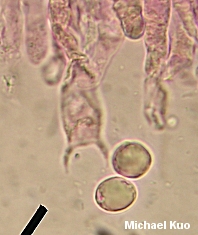| Major Groups > Clubs & Corals > Clavulina rugosa |

|
Clavulina rugosa [ Basidiomycetes > Cantharellales > Clavulinaceae > Clavulina . . . ] by Michael Kuo In its "pure" form Clavulina rugosa is fairly easily identified by its unbranched or sparingly branched structure, its white color, its rugged surface, and its blunt branch tips. Its surfaces do not turn green when iron salts are applied, and its microscopic features (see below) are distinctive. However, collections are not infrequently made in which the branching is more profuse, the surface is less rugged, and the branch tips become "cristate" like those in Clavulina cristata. Clavulina rugosa even appears to parallel Clavulina cristata in being frequently attacked by the pyrenomycete Helminthosphaeria clavariarum, which turns the white colors to gray or black. In short, Clavulina cristata and Clavulina rugosa may represent the extreme ends of a continuum (an idea perhaps supported by the fact that their microscopic features are very similar), which might imply that there is only one species involved. Description: Ecology: Presumably mycorrhizal; found under conifers and hardwoods; growing alone, gregariously, or in clusters; summer and fall (over winter in warm climates); widely distributed in North America. Fruiting Body: 4-12 cm high; to 1.5 cm wide; unbranched or divided one to several times (often appearing antler-like). Branches: Rugged; white, sometimes developing yellowish tints with age; yellow when dried for the herbarium; tips colored like the sides, blunt or occasionally "cristate" with several sharp points; when parasitized becoming dark gray to black from the base upward. Base: Not clearly separate from the upper portion of the fruiting body. Flesh: Whitish; fairly tough. Odor and Taste: Not distinctive. Spore Print: White. Chemical Reactions: Irons salts negative on branches. Microscopic Features: Spores 9-14 x 8-12 µ; subglobose or broadly elliptical; smooth; with an apiculus. Basidia clavate; 40-85 x 6-9.5 µ; 2-sterigmate with long (6-9 µ), incurved sterigmata. Clamp connections present. REFERENCES: (Bulliard, 1790) Schröter, 1888. (Fries, 1821; Saccardo, 1888; Coker, 1923; Corner, 1950; Arora, 1986; Barron, 1999; McNeil, 2006.) Herb. Kuo 01150602. This site contains no information about the edibility or toxicity of mushrooms. |
© MushroomExpert.Com |
|
Cite this page as: Kuo, M. (2007, April). Clavulina rugosa. Retrieved from the MushroomExpert.Com Web site: http://www.mushroomexpert.com/clavulina_rugosa.html |


